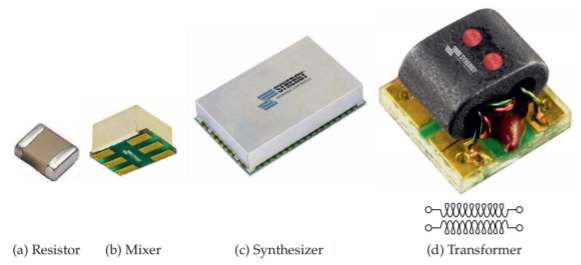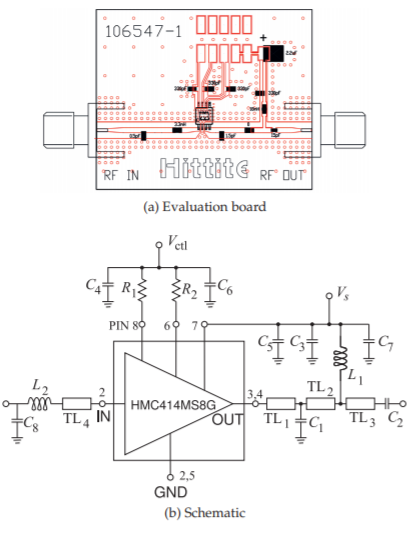5.1: Introduction to Passive Modules
( \newcommand{\kernel}{\mathrm{null}\,}\)
Most RF systems are composed of a cascade of modules each of which is separately designed and characterized. They usually have matched 50Ω input and output impedances so that modules can be freely interconnected. In high volume applications, several modules could be monolithically integrated, but even then, design is based on the concept of modules. Many modules are available “off the shelf” and high-performance RF systems can be constructed using commercially available modules, see Figure 5.1.1.
Many modules are available mounted on evaluation boards complete with biasing components and SMA connectors so that RF modules can be interconnected using coaxial cables. For example, an evaluation board is shown in Figure 5.1.2 for a power amplifier. The engineer needs to attach supply, Vs, ground, and control voltage Vctl, and the evaluation board provides a working amplifier. Most RF and microwave engineers work at the circuit board level and begin system design using modules. Some companies develop some of their own proprietary modules, thus providing a competitive advantage, but still use many modules developed by others. An estimate sometimes made is that the value of RF and microwave circuit-board-based module-using engineering is 30 times larger than the value of module and RF integrated circuit engineering.
The modules that comprise a receiver are shown in Figure 5.1.3. Beginning with the bandpass filter after the antenna, each module contributes noise and nonlinear distortion. The system design objectives are generally to maximize dynamic range, the region between the signal being sufficiently above the noise level to be detected but before nonlinear distortion introduces spurious

Figure 5.1.1: Modules in surface-mount packages. Copyright Synergy Microwave Corporation, used with permission [1].

Figure 5.1.2: Evaluation board for the HMC414MS8G GaAs InGaP HBT MMIC power amplifier module operating between 2.2 and 2.8 GHz. The amplifier provides 20 dB of gain and +30 dBm of saturated power at 32% PAE from a +5V supply voltage. The amplifier can also operate with a 3.6 V supply selectable by the resistors R1 and R2. Copyright Hittite Microwave Corporation, used with permission [2].

Figure 5.1.3: Receiver as a cascade of modules.
| Component | Symbol |
|---|---|
| Diode, general (including Schottky)1 |  |
| IMPATT diode1 |  |
| Gunn diode |  |
| PIN diode1,2 |  |
| Light emitting diode (LED)1 |  |
| Rectifier1 |  |
| Tunnel diode1 |  |
| Varactor diode1 |  |
| Zener diode1 |  |
Table 5.1.1: IEEE standard symbols for diodes and a rectifier [3]. (1In the direction of anode (A) to cathode (K). 2Use symbol for general diode unless it is essential to show the intrinsic region.)
signals that limit the detectability of signals. At the same time, it is usual to try and minimize the power consumed. This is particularly important in mobile applications.
This chapter introduces many passive modules;modules and microwave functional elements that do not require external supplies with he exception of perhaps control voltages.


